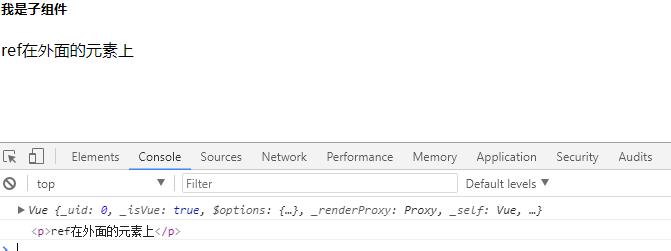VueJs---组件(父子通讯)
Posted 雨点的名字
tags:
篇首语:本文由小常识网(cha138.com)小编为大家整理,主要介绍了VueJs---组件(父子通讯)相关的知识,希望对你有一定的参考价值。
组件(父子通讯)
一、概括
在一个组件内定义另一个组件,称之为父子组件。
但是要注意的是:1.子组件只能在父组件内部使用(写在父组件tempalte中);
2.默认情况下,子组件无法访问父组件上的数据,每个组件实例的作用域是独立的;
那如何完成父子如何完成通讯,简单一句话:props down, events up :父组件通过 props 向下传递数据给子组件,子组件通过 events 给父组件发送
父传子:Props
子传父:子:$emit(eventName) 父$on(eventName)
父访问子:ref
下面对三个进行案例讲解:
二、父传子:Props
组件实例的作用域是孤立的。这意味着不能 (也不应该) 在子组件的模板内直接引用父组件的数据。要让子组件使用父组件的数据,需要通过子组件的 props 选项
使用Prop传递数据包括静态和动态两种形式,下面先介绍静态props
1、静态props
<script src="https://unpkg.com/vue"></script> <div id="example"> <parent></parent> </div> <script> //要想子组件能够获取父组件的,那么在子组件必须申明:props var childNode = { template: \'<div>{{message}}</div>\', props: [\'message\'] } //这里的message要和上面props中值一致 var parentNode = { template: ` <div class="parent"> <child message="我是"></child> <child message="徐小小"></child> </div>`, components: { \'child\': childNode } }; // 创建根实例 new Vue({ el: \'#example\', components: { \'parent\': parentNode } }) </script>
效果:

命名约定:
对于props声明的属性来说,在父级html模板中,属性名需要使用中划线写法
子级props属性声明时,使用小驼峰或者中划线写法都可以;而子级模板使用从父级传来的变量时,需要使用对应的小驼峰写法
上面这句话什么意思呢?
<script> //这里需要注意的是props可以写成[\'my-message\']或者[\'myMessage\']都是可以的 //但是template里的属性名,只能是驼峰式{{myMessage}},如果也写成{{my-message}}那么是无效的 var childNode = { template: \'<div>{{myMessage}}</div>\', props: [\'myMessage\'] } //这里的属性名为my-message var parentNode = { template: ` <div class="parent"> <child my-message="我是"></child> <child my-message="徐小小"></child> </div>`, components: { \'child\': childNode } }; </script>
如果我们childNode中的myMessage改成{{my-message}}看运行结果:

2.动态props
在模板中,要动态地绑定父组件的数据到子模板的 props,与绑定到任何普通的HTML特性相类似,就是用 v-bind。每当父组件的数据变化时,该变化也会传导给子组件
var childNode = { template: \'<div>{{myMessage}}</div>\', props: [\'my-message\'] } var parentNode = { template: ` <div class="parent"> <child :my-message="data1"></child> <child :my-message="data2"></child> </div>`, components: { \'child\': childNode }, data() { return { \'data1\': \'111\', \'data2\': \'222\' } } };
3、传递数字
初学者常犯的一个错误是使用字面量语法传递数值
<script src="https://unpkg.com/vue"></script> <div id="example"> <parent></parent> </div> <script> var childNode = { template: \'<div>{{myMessage}}的类型是{{type}}</div>\', props: [\'myMessage\'], computed: { type() { return typeof this.myMessage } } } var parentNode = { template: ` <div class="parent"> <my-child my-message="1"></my-child> </div>`, components: { \'myChild\': childNode } }; // 创建根实例 new Vue({ el: \'#example\', components: { \'parent\': parentNode } }) </script>
结果:

因为它是一个字面 prop,它的值是字符串 "1" 而不是 number。如果想传递一个实际的 number,需要使用 v-bind,从而让它的值被当作JS表达式计算
如何把String转成number呢,其实只要改一个地方。
var parentNode = { template: ` <div class="parent"> //只要把父组件my-message="1"改成:my-message="1"结果就变成number类型 <my-child :my-message="1"></my-child> </div>`, };
当然你如果想通过v-bind想传一个string类型,那该怎么做呢?
我们可以使用动态props,在data属性中设置对应的数字1
var parentNode = { template: ` <div class="parent"> <my-child :my-message="data"></my-child> </div>`, components: { \'myChild\': childNode }, //这里\'data\': 1代表就是number类型,\'data\': "1"那就代表String类型 data(){ return { \'data\': 1 } } };
三、子转父 :$emit
关于$emit的用法
1、父组件可以使用 props 把数据传给子组件。
2、子组件可以使用 $emit 触发父组件的自定义事件。
子主键
<template>
<div class="train-city">
<span @click=\'select(`大连`)\'>大连</span>
</div>
</template>
<script>
export default {
name:\'trainCity\',
methods:{
select(val) {
let data = {
cityname: val
};
this.$emit(\'showCityName\',data);//select事件触发后,自动触发showCityName事件
}
}
}
</script>
父组件
<template>
<trainCity @showCityName="updateCity" :index="goOrtoCity"></trainCity> //监听子组件的showCityName事件。
<template>
<script>
export default {
name:\'index\',
data () {
return {
toCity:"北京"
}
}
methods:{
updateCity(data){//触发子组件城市选择-选择城市的事件
this.toCity = data.cityname;//改变了父组件的值
console.log(\'toCity:\'+this.toCity)
}
}
}
</script>
结果为:toCity: 大连
第二个案例
<script src="https://unpkg.com/vue"></script> <div id="counter-event-example"> <p>{{ total }}</p> <button-counter v-on:increment1="incrementTotal"></button-counter> <button-counter v-on:increment2="incrementTotal"></button-counter> </div> <script> Vue.component(\'button-counter\', { template: \'<button v-on:click="increment">{{ counter }}</button>\', //组件数据就是需要函数式,这样的目的就是让每个button-counter不共享一个counter data: function() { return { counter: 0 } }, methods: { increment: function() {
//这里+1只对button的值加1,如果要父组件加一,那么就需要$emit事件 this.counter += 1; this.$emit(\'increment1\', [12, \'kkk\']); } } }); new Vue({ el: \'#counter-event-example\', data: { total: 0 }, methods: { incrementTotal: function(e) { this.total += 1; console.log(e); } } }); </script>
详细讲解:
1:button-counter作为父主键,父主键里有个button按钮。
2:两个button都绑定了click事件,方法里: this.$emit(\'increment1\', [12, \'kkk\']);,那么就会去调用父类v-on所监听的increment1事件。
3:当increment1事件被监听到,那么执行incrementTotal,这个时候才会把值传到父组件中,并且调用父类的方法。
4:这里要注意第二个button-counter所对应的v-on:\'increment2,而它里面的button所对应是this.$emit(\'increment1\', [12, \'kkk\']);所以第二个button按钮是无法把值传给他的父主键的。
示例:一个按钮点击一次那么它自身和上面都会自增1,而第二个按钮只会自己自增,并不影响上面这个。

还有就是第一个按钮每点击一次,后台就会打印一次如下:

四、ref ($refs)用法
ref 有三种用法
1.ref 加在普通的元素上,用this.ref.name 获取到的是dom元素
2.ref 加在子组件上,用this.ref.name 获取到的是组件实例,可以使用组件的所有方法。
3.如何利用v-for 和ref 获取一组数组或者dom 节点
1.ref 加在普通的元素上,用this.ref.name 获取到的是dom元素
<script src="https://unpkg.com/vue"></script> <div id="ref-outside-component" v-on:click="consoleRef"> <component-father ref="outsideComponentRef"> </component-father> <p>ref在外面的组件上</p> </div> <script> var refoutsidecomponentTem = { template: "<div class=\'childComp\'><h5>我是子组件</h5></div>" }; var refoutsidecomponent = new Vue({ el: "#ref-outside-component", components: { "component-father": refoutsidecomponentTem }, methods: { consoleRef: function() { console.log(this.); // #ref-outside-component vue实例 console.log(this.$refs.outsideComponentRef); // div.childComp vue实例 } } }); </script>
效果:当在div访问内点击一次:

2.ref使用在外面的元素上
<script src="https://unpkg.com/vue"></script> <!--ref在外面的元素上--> <div id="ref-outside-dom" v-on:click="consoleRef"> <component-father> </component-father> <p ref="outsideDomRef">ref在外面的元素上</p> </div> <script> var refoutsidedomTem = { template: "<div class=\'childComp\'><h5>我是子组件</h5></div>" }; var refoutsidedom = new Vue({ el: "#ref-outside-dom", components: { "component-father": refoutsidedomTem }, methods: { consoleRef: function() { console.log(this); // #ref-outside-dom vue实例 console.log(this.$refs.outsideDomRef); // <p> ref在外面的元素上</p> } } }); </script>
效果:当在div访问内点击一次:

3.ref使用在里面的元素上---局部注册组件
<script src="https://unpkg.com/vue"></script> <!--ref在里面的元素上--> <div id="ref-inside-dom"> <component-father> </component-father> <p>ref在里面的元素上</p> </div> <script> var refinsidedomTem = { template: "<div class=\'childComp\' v-on:click=\'consoleRef\'>" + "<h5 ref=\'insideDomRef\'>我是子组件</h5>" + "</div>", methods: { consoleRef: function() { console.log(this); // div.childComp vue实例 console.log(this.$refs.insideDomRef); // <h5 >我是子组件</h5> } } }; var refinsidedom = new Vue({ el: "#ref-inside-dom", components: { "component-father": refinsidedomTem } }); </script>
效果:当在click范围内点击一次:

4.ref使用在里面的元素上---全局注册组件
<script src="https://unpkg.com/vue"></script> <!--ref在里面的元素上--全局注册--> <div id="ref-inside-dom-all"> <ref-inside-dom-quanjv></ref-inside-dom-quanjv> </div> <script> //v-on:input指当input里值发生改变触发showinsideDomRef事件 Vue.component("ref-inside-dom-quanjv", { template: "<div class=\'insideFather\'> " + "<input type=\'text\' ref=\'insideDomRefAll\' v-on:input=\'showinsideDomRef\'>" + " <p>ref在里面的元素上--全局注册 </p> " + "</div>", methods: { showinsideDomRef: function() { console.log(this); //